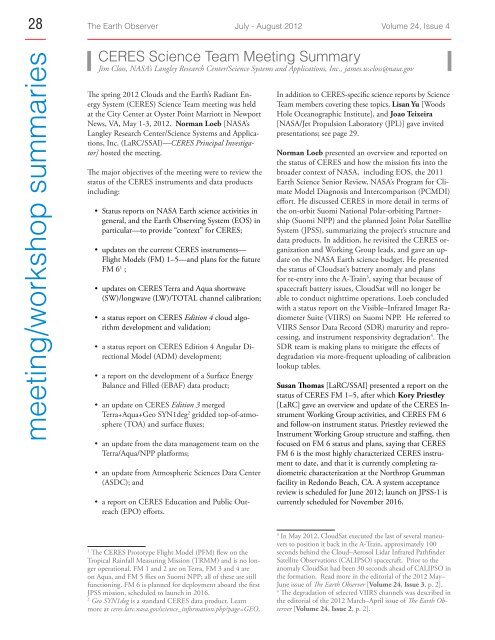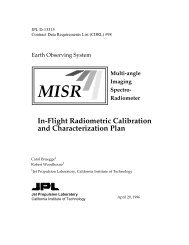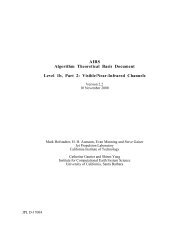Download - NASA's Earth Observing System
Download - NASA's Earth Observing System
Download - NASA's Earth Observing System
Create successful ePaper yourself
Turn your PDF publications into a flip-book with our unique Google optimized e-Paper software.
28<br />
The <strong>Earth</strong> Observer July - August 2012 Volume 24, Issue 4<br />
meeting/workshop summaries<br />
CERES Science Team Meeting Summary<br />
Jim Closs, NASA’s Langley Research Center/Science <strong>System</strong>s and Applications, Inc., james.w.closs@nasa.gov<br />
The spring 2012 Clouds and the <strong>Earth</strong>’s Radiant Energy<br />
<strong>System</strong> (CERES) Science Team meeting was held<br />
at the City Center at Oyster Point Marriott in Newport<br />
News, VA, May 1-3, 2012. Norman Loeb [NASA’s<br />
Langley Research Center/Science <strong>System</strong>s and Applications,<br />
Inc. (LaRC/SSAI)—CERES Principal Investigator]<br />
hosted the meeting.<br />
The major objectives of the meeting were to review the<br />
status of the CERES instruments and data products<br />
including:<br />
• Status reports on NASA <strong>Earth</strong> science activities in<br />
general, and the <strong>Earth</strong> <strong>Observing</strong> <strong>System</strong> (EOS) in<br />
particular—to provide “context” for CERES;<br />
• updates on the current CERES instruments—<br />
Flight Models (FM) 1–5—and plans for the future<br />
FM 6 1 ;<br />
• updates on CERES Terra and Aqua shortwave<br />
(SW)/longwave (LW)/TOTAL channel calibration;<br />
• a status report on CERES Edition 4 cloud algorithm<br />
development and validation;<br />
• a status report on CERES Edition 4 Angular Directional<br />
Model (ADM) development;<br />
• a report on the development of a Surface Energy<br />
Balance and Filled (EBAF) data product;<br />
• an update on CERES Edition 3 merged<br />
Terra+Aqua+Geo SYN1deg 2 gridded top-of-atmosphere<br />
(TOA) and surface fluxes;<br />
• an update from the data management team on the<br />
Terra/Aqua/NPP platforms;<br />
• an update from Atmospheric Sciences Data Center<br />
(ASDC); and<br />
• a report on CERES Education and Public Outreach<br />
(EPO) efforts.<br />
In addition to CERES-specific science reports by Science<br />
Team members covering these topics, Lisan Yu [Woods<br />
Hole Oceanographic Institute], and Joao Teixeira<br />
[NASA/Jet Propulsion Laboratory (JPL)] gave invited<br />
presentations; see page 29.<br />
Norman Loeb presented an overview and reported on<br />
the status of CERES and how the mission fits into the<br />
broader context of NASA, including EOS, the 2011<br />
<strong>Earth</strong> Science Senior Review, NASA’s Program for Climate<br />
Model Diagnosis and Intercomparison (PCMDI)<br />
effort. He discussed CERES in more detail in terms of<br />
the on-orbit Suomi National Polar-orbiting Partnership<br />
(Suomi NPP) and the planned Joint Polar Satellite<br />
<strong>System</strong> (JPSS), summarizing the project’s structure and<br />
data products. In addition, he revisited the CERES organization<br />
and Working Group leads, and gave an update<br />
on the NASA <strong>Earth</strong> science budget. He presented<br />
the status of Cloudsat’s battery anomaly and plans<br />
for re-entry into the A-Train 3 , saying that because of<br />
spacecraft battery issues, CloudSat will no longer be<br />
able to conduct nighttime operations. Loeb concluded<br />
with a status report on the Visible–Infrared Imager Radiometer<br />
Suite (VIIRS) on Suomi NPP. He referred to<br />
VIIRS Sensor Data Record (SDR) maturity and reprocessing,<br />
and instrument responsivity degradation 4 . The<br />
SDR team is making plans to mitigate the effects of<br />
degradation via more-frequent uploading of calibration<br />
lookup tables.<br />
Susan Thomas [LaRC/SSAI] presented a report on the<br />
status of CERES FM 1–5, after which Kory Priestley<br />
[LaRC] gave an overview and update of the CERES Instrument<br />
Working Group activities, and CERES FM 6<br />
and follow-on instrument status. Priestley reviewed the<br />
Instrument Working Group structure and staffing, then<br />
focused on FM 6 status and plans, saying that CERES<br />
FM 6 is the most highly characterized CERES instrument<br />
to date, and that it is currently completing radiometric<br />
characterization at the Northrop Grumman<br />
facility in Redondo Beach, CA. A system acceptance<br />
review is scheduled for June 2012; launch on JPSS-1 is<br />
currently scheduled for November 2016.<br />
1<br />
The CERES Prototype Flight Model (PFM) flew on the<br />
Tropical Rainfall Measuring Mission (TRMM) and is no longer<br />
operational. FM 1 and 2 are on Terra, FM 3 and 4 are<br />
on Aqua, and FM 5 flies on Suomi NPP; all of these are still<br />
functioning. FM 6 is planned for deployment aboard the first<br />
JPSS mission, scheduled to launch in 2016.<br />
2<br />
Geo SYN1deg is a standard CERES data product. Learn<br />
more at ceres.larc.nasa.gov/science_information.phppage=GEO.<br />
3<br />
In May 2012, CloudSat executed the last of several maneuvers<br />
to position it back in the A-Train, approximately 100<br />
seconds behind the Cloud–Aerosol Lidar Infrared Pathfinder<br />
Satellite Observations (CALIPSO) spacecraft. Prior to the<br />
anomaly CloudSat had been 30 seconds ahead of CALIPSO in<br />
the formation. Read more in the editorial of the 2012 May–<br />
June issue of The <strong>Earth</strong> Observer [Volume 24, Issue 3, p. 2].<br />
4<br />
The degradation of selected VIIRS channels was described in<br />
the editorial of the 2012 March–April issue of The <strong>Earth</strong> Observer<br />
[Volume 24, Issue 2, p. 2].







